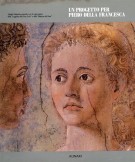The Springtime of the Renaissance Sculpture and the Arts in Florence 1400-60
| Author(s) | edited by Beatrice Paolozzi Strozzi e Marc Bormand | ||
| Editor | Mandragora | Place | Firenze |
| Year | 2013 | Pages | 560 |
| Measure | 24x29 (cm) | Illustration | 200 ill. a colori - colors ills |
| Binding | cart. edit. ill. colori - Hardcover | Conservazione | Nuovo - New |
| Language | Inglese - English text | Weight | 3600 (gr) |
| ISBN | 8874611862 | EAN-13 | 9788874611867 |
not available
Florence, Palazzo Strozzi, 23 March - 18 August 2013.
English catalogue.
The exhibition proposes to illustrate, in theme-based Sections, the origin of what is still known today as the 'miracle' of the Renaissance in Florence. The catalogue proposes to illustrate, in theme-based sections, the origin of what is still known today as the “miracle” of the Renaissance in Florence, doing so principally through masterpieces of sculpture, the branch of figurative art in which that new season first saw the light of day. The first section is devoted to the rediscovery of the ancient world during the “rebirth” that occurred between the 13th and 14th centuries – from Nicola Pisano to Arnolfo di Cambio and their successors – especially of French origin. The two panels depicting the Sacrifice of Isaac by Lorenzo Ghiberti and Filippo Brunelleschi and the model of Brunelleschi’s Dome of Florence Cathedral represent the fundamental starting point of the Early Renaissance. Monumental public sculpture by Donatello and Ghiberti, is the first and loftiest testimony of innovation. From the 1420s on, the new standards of sculpture perfected by the great masters and illustrated by a number of masterpieces. At the same time, the most prestigious artistic commissions in Florence began to focus on venues of solidarity and of prayer. Thus, arranged around the city’s absolute symbol – the wooden model of Brunelleschi’s Cupola for Santa Maria del Fiore – the exhibition offers a retrospective of sculpture that was also to have a crucial impact on the development of the other figurative arts, in a direct debate with its classical predecessors, from the tombs of the Humanists, to the rebirth of the equestrian monument and the carved portrait. The carved portrait, which started to become popular towards the middle of the century – in the marble busts of Mino da Fiesole, Desiderio da Settignano and Antonio Rossellino – heralds the transition from fiorentina libertas to the private patronage that was soon to lead to the hegemony of the Medici family. In this context, the exhibition – wich opened whith the evocation of Brunelleschi’s dome – closes with the evocation of the most illustrious private residence of the Renaissance in the shape of a Wooden Model of Palazzo Strozzi. (T-CA)
Recommended books...





